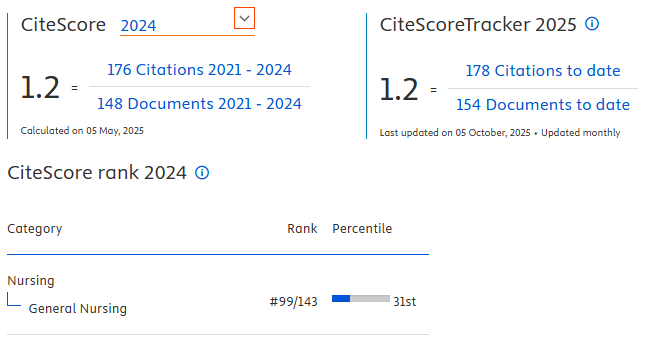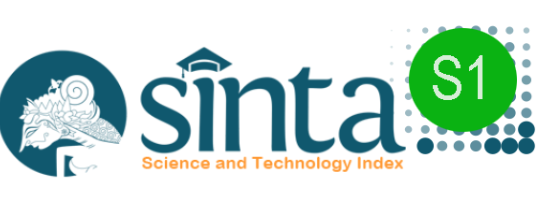Effects of murottal al-qur'an therapy on anxiety and vital signs among primigravida pregnant women in pre-operation caesarean section

Downloads
Introduction: This research aims to analyze the effect of Murottal Al-Qur'an Therapy on reducing anxiety and vital signs in primigravid pregnant women before C-Section surgery.
Methods: A quasi-experimental study on pregnant women who will undergo C-Section surgery at a hospital in Surabaya, Indonesia. A total of 84 respondents (42 in the intervention group and 42 in the control group) were recruited using purposive sampling. Anxiety variables were measured using the Zung Self-Rating Anxiety Scale (ZSRAS), and vital signs (pulse, blood pressure, respiration rate) were measured using a sphygmomanometer and a calibrated clock. Data analysis was used to test the Wilcoxon Signed Rank Test and the Mann-Whitney Test.
Results: The intervention group's vital signs for blood pressure decreased to 120.98 mmHg and diastolic blood pressure to 70.08 mmHg. The mother's pulse showed an average of 79.95 times per minute and respiration an average of 20 times per minute. Testing the effect of Murottal Al-Qur'an Therapy showed a significant effect on the Intervention group for anxiety (p=0.001), systolic pressure (p=0.005), diastolic pressure (p=0.001), pulse (p=0.005), and respiration rate (p=0.001), respectively. The difference test shows a significant difference after the intervention, with a p-value of <0.001.
Conclusions: Murottal Al-Qur'an Therapy can reduce anxiety levels, systolic and diastolic blood pressure, pulse rate, and respiration rate in primigravida pregnant women who will undergo C-Section surgery. So, the results of this research can be applied by primary nurses in maternity rooms or operating rooms for primigravida pregnant patients who will undergo cesarean Section surgery.
AB RAHMAN, Z. et al. (no date) ‘Aspect of Religious Coping, Element of Neuroscience, Al-Quran Recital Approaches and Resilience among University Students in the Post-Covid-19 Pandemic’.
Agrevita, A. (2021) ‘Asuhan Keperawatan pada Pasien Preeklamsia Post Operasi Sectio Caesarea dengan Gangguan Pemenuhan Rasa Nyaman (Nyeri) di RSUD Labuang Baji Makassar’. Universitas Islam Negeri Alauddin Makassar.
Aker, M. N., Cengiz, H. Ö. and Sezer, N. Y. (2024) ‘The effect of guided imagery pre-cesarean section on the perceived preoperative anxiety, surgical fear, and physiological parameters of women: A randomized controlled trial’, European Journal of Integrative Medicine, 68, p. 102362.
Alsufyani, F. et al. (2024) ‘The Impact of Educational Sessions on Anxiety Levels among Women Undergoing Caesarean Section: A Quasi-Experimental Study’, European Journal of Investigation in Health, Psychology and Education, 14(2), pp. 324–338.
Anggara, A., Triyudono, D. and Suryani, R. L. (2024) ‘Impact of Visual and Aural Education on the Anxiety Level of Patients Under Spinal Anesthesia for Preoperative Caesarean Section’, Java Nursing Journal, 2(1), pp. 57–64.
Ashar, H. and Kusrini, I. (2020) ‘Determinant of the Increased Sectio Caesarea Labor Rates of Indonesia in 2017’, in 4th International Symposium on Health Research (ISHR 2019). Atlantis Press, pp. 268–272.
Dewi, A. P. S. et al. (2022) ‘The Role of Early Mobilization on Wound Healing After Sectio Caesarea’, Journal of Sexual and Reproductive Health Sciences, 1(1), pp. 7–14.
East Java Provincial Health Office (2022) East Java Provincial Health Service Report.
Emilia, N. L. et al. (2022) ‘Efektifitas Terapi Relaksasi Benson Untuk Menurunkan Kecemasan Pada Mahasiswa Peserta Uji Kompetensi Di Stikes Bala Keselamatan Palu’, An Idea Health Journal, 2(03), pp. 111–116.
Fentie, Y., Yetneberk, T. and Gelaw, M. (2022) ‘Preoperative anxiety and its associated factors among women undergoing elective caesarean delivery: a cross-sectional study’, BMC Pregnancy and Childbirth, 22(1), p. 648.
Gedefaw, G. et al. (2020) ‘Prevalence, indications, and outcomes of caesarean section deliveries in Ethiopia: a systematic review and meta-analysis’, Patient safety in surgery, 14, pp. 1–10.
Ghorbani, A. et al. (2021) ‘Effect of spiritual group therapy on depression, anxiety and stress of the mothers of children with cancer’, Complementary Medicine Journal, 11(3), pp. 196–209.
Hamranani, S. S. T. et al. (2023) ‘Murottal Therapy Reduce the Level of Anxiety in Patients Pre Operating Sectio Caesarea in Klaten Islamic General Hospital’, Pakistan Journal of Life and Social Sciences, 21(1), pp. 180–193.
Handayani, R. et al. (2014) ‘Pengaruh terapi murottal Al-Quran untuk penurunan nyeri persalinan dan kecemasan pada ibu bersalin kala i fase aktif’, Jurnal ilmiah kebidanan, 5(2), pp. 1–15.
Hunter, A. R. et al. (2023) ‘The effects of music-based interventions for pain and anxiety management during vaginal labour and caesarean delivery: A systematic review and narrative synthesis of randomised controlled trials’, International Journal of Environmental Research and Public Health, 20(23), p. 7120.
Ismayanti, I. et al. (2021) ‘Murottal Qur’an to Lower Anxiety Rate on Pre-Operative Patients’, International Journal of Nursing and Health Services (IJNHS), 4(4), pp. 447–457.
Jaya, N. and Kadhim, S. (2022) ‘Classic Mozart And Murrotal Alquran Therapy Music For Increasing Body Weight In LBW Infants’, Journal of Applied Nursing and Health, 4(2), pp. 277–282.
Kamila, N. A. and Mutianingsih, R. (2021) ‘Effectiveness of Al-Qur’an tadabbur therapy on nulliparous women’s anxiety level during labor’, Global Medical and Health Communication, 9(1), pp. 55–60.
Khosravi, F. et al. (2022) ‘The effect of a spirituality-based program on stress, anxiety, and depression of caregivers of patients with mental disorders in Iran’, Journal of religion and health, pp. 1–16.
Lupu, V. V. et al. (2023) ‘Difficulties in adaptation of the mother and newborn via cesarean section versus natural birth—A narrative review’, Life, 13(2), p. 300.
Maulidia, Z. and Muladiatin, I. (2018) ‘Terapi Murotal Al-Quran Terhadap Penurunan Tingkat Kecemasan Pada Pasien Post Operasi Sectio Caesarea’, Jurnal Kesehatan, 7(1), pp. 23–34.
Mulugeta, A. K. et al. (2020) ‘Knowledge about birth preparedness and complication readiness and associated factors among primigravida women in Addis Ababa governmental health facilities, Addis Ababa, Ethiopia, 2015’, Reproductive health, 17, pp. 1–13.
Munkhondya, B. M. J. et al. (2020) ‘A qualitative study of childbirth fear and preparation among primigravid women: The blind spot of antenatal care in Lilongwe, Malawi’, International journal of nursing sciences, 7(3), pp. 303–312.
Nazir, A. (2023) ‘The Effect of Listening to the Holy Qur’an Recitation Therapy onPhysiological Parameters and Neuropsychological Functionsin Intensive Care Unit Patients: A Narrative Reviewfrom Physical and Rehabilitation Medicine Point of View’, Iranian Rehabilitation Journal, 21(2), pp. 215–222.
Nuhan, K., Astuti, T. and Murhan, A. (2018) ‘Pengaruh Murottal Al-Qur’an terhadap Intensitas Nyeri pada Pasien Post Operasi Sectio Caesarea’, Jurnal Ilmiah Keperawatan Sai Betik, 14(1), pp. 91–97.
Nurhasanah, C., Yushida, Y. and Yuniwati, C. (2022) ‘The Effectiveness of Deep Relaxation Techniques and Murotal Al-Qur’an Audio on Pain of Labor Pain in the Working Area of Health Center, Ingin Jaya District, Aceh Besar, Indonesia’, EAS Journal of Nursing and Midwifery, 4(6), pp. 182–185.
De Paolis, G. et al. (2019) ‘The effectiveness of progressive muscle relaxation and interactive guided imagery as a pain-reducing intervention in advanced cancer patients: A multicentre randomised controlled non-pharmacological trial’, Complementary therapies in clinical practice, 34, pp. 280–287. doi: 10.1016/j.ctcp.2018.12.014.
Pervez, T. (2021) ‘Spinal Anesthesia (SA) and Patient Satisfaction in Cesearan Section (CS); A Comparative Study’, Journal of Wazir Muhammad Institute of Paramedical Technology, 1(1), pp. 11–16.
Pulungan, N. K., Harahap, M. and Hasibuan, E. (2022) ‘Factors Affecting Sectio Caesarea Delivery at the Padangsidimpuan City Regional General Hospital’, International Journal of Public Health Excellence (IJPHE), 1(1), pp. 17–20.
Rozali, C. W. M. et al. (2022) ‘The Impact of Listening to, Reciting, or Memorizing the Quran on Physical and Mental Health of Muslims: Evidence From Systematic Review.’, International journal of public health, 67, p. 1604998.
Safitri, Y., Juwita, D. S. and Apriyandi, F. (2022) ‘PENGARUH TERAPI MUSIK ISLAMI TERHADAP KECEMASAN PADA LANSIA YANG MENGALAMI HIPERTENSI DI DESA BATU BELAH WILAYAH KERJA PUSKESMAS AIR TIRIS KECAMATAN KAMPAR TAHUN 2022’, Jurnal Ners, 6(2), pp. 138–143.
Shimanoe, C. et al. (2021) ‘Perceived stress, depressive symptoms, and cortisol-to-cortisone ratio in spot urine in 6878 older adults’, Psychoneuroendocrinology, 125, p. 105125.
Subhi, I., Budiono, I. and Wijayanti, Y. (2023) ‘The Influence of Caesarean Section Education Program and Quranic Recitation Therapy on Anxiety Levels in Preoperative Patients at RA Kartini Hospital, Jepara Regency’, Journal of Health Education, 8(1), pp. 31–40.
Sungkar, A. and Basrowi, R. W. (2020) ‘Rising trends and indication of caesarean section in Indonesia’, World Nutrition Journal, 4(S2), pp. 1–7.
Trisnawati, D., Suryati, Y. and Susilawati, S. (2022) ‘Spiritual Mindfulness Based on Breathing Exercise terhadap Kecemasan dan Kadar Glukosa Darah pada Pasien DM Tipe 2’, Jurnal Keperawatan Silampari, 6(1), pp. 425–438.
Ulfah, D. M., Fauziah, H. and Sari, A. T. (2024) ‘Effect of Murottal Al-Quran Therapy on Neuromuscular Maturity of Premature Babies’, Jurnal Kebidanan, 13(2), pp. 120–125.
Verma, V. et al. (2020) ‘Prevalence and determinants of caesarean section in South and South-East Asian women’, PloS one, 15(3), p. e0229906.
Wigatiningsih, Y., Hermawan, H. and Elisa, E. (2020) ‘Pengaruh Pemberian Terapi Musik (Murottal) terhadap Kecemasan pada Pasien Pre Operasi Sectio Caesarea di Ruang Instalasi Bedah Sentral (IBS) RSUD KRMT Wongsonegoro’, JURNAL KEPERAWATAN MERSI, 9(1), pp. 19–22.
Wulandari, S. et al. (2023) ‘Effectiveness of Preoperating Teaching with Anxiety Levels in Preoperating Sectio Caesarea Patients’, Journal for Quality in Public Health, 6(2), pp. 352–364.
Zahroh, R. I. et al. (2020) ‘Trends and sociodemographic inequalities in the use of caesarean section in Indonesia, 1987-2017’, BMJ global health, 5(12), p. e003844
Copyright (c) 2025 Jurnal Ners

This work is licensed under a Creative Commons Attribution 4.0 International License.
Authors who publish with Jurnal Ners agree to the following terms:
- Authors transfer the Copyright and grant Jurnal Ners the right of first publication with the work simultaneously licensed under a Creative Commons Attribution 4.0 International License that allows others to remix, adapt and build upon the work with an acknowledgment of the work's authorship and of the initial publication in Jurnal Ners.
- Authors are permitted to copy and redistribute the journal's published version of the work (e.g., post it to an institutional repository or publish it in a book), with an acknowledgment of its initial publication in Jurnal Ners.
Jurnal Ners requires a formal written declaration and transfer of copyright from the author(s) for each article published. We, therefore, ask you to complete and return this form, retaining a copy for your own records. Your cooperation is essential and appreciated. Any delay will result in a delay in publication. The form can be downloaded HERE.
































